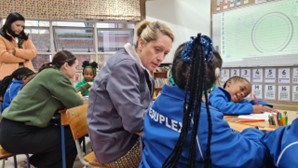Related Products
For Professionals
- Amplification
- Assessment of Student Skills, Challenges, Needs
- Early Childhood: Infants, Toddlers, Preschool
- Hearing Loss – Identification, Impact and Next Steps
- IDEA Law Summary Information
- Language and Speech Development Issues
- Legal Issues in Serving Children with Hearing Loss
- Listening (Auditory Skills) Development
- Planning to Meet Student Needs
- Self-Advocacy Skills for Students with Hearing Loss
- Self-Concept: How the Child with Hearing Loss Sees Himself
- Social Skills
- Speech Perception & Learning
Related Teacher Tools Takeout Items
Lost in the Noise: The Learning Gap for Deaf and Hard of Hearing Children

The majority of students with hearing loss in mainstream educational settings are expected to learn primarily through auditory modalities. The role of itinerant teachers of the deaf is critical in supporting both school personnel and students by providing guidance on best practices and necessary accommodations. Their expertise helps to ensure that students with hearing loss have equitable access to the curriculum.
Itinerant teachers serve a vital role in educating and training general education teachers, most of whom may lack a comprehensive understanding of the educational implications of hearing loss across various classroom environments. Although the responsibility for instruction has shifted to general education teachers, many are not adequately prepared to meet the learning needs of deaf and hard of hearing (DHH) students. This lack of understanding can intensify the existing gap in academic and functional delays in a population already at increased risk of falling behind.
Research indicates that DHH students often perform better academically in mainstream settings compared to special education placements (Antia, Jones, Reed, & Kreimeyer, 2009; Stinson & Kluwin, 2003). However, general education teachers typically lack the specialized training required to fully support DHH learners. These students often struggle with listening, language development, and literacy, and are particularly vulnerable to auditory fatigue. This form of fatigue can have physical, cognitive, and socio-emotional consequences, further hindering learning and classroom participation.
To address these challenges, it is essential that strategies to enhance access—such as classroom modifications, amplification technology, and communication supports—are implemented proactively. Itinerant teachers must provide this training at the start of the academic year and any time students transition to new classes or teachers to ensure continuity of support and access to learning.
The Listen to Learn for Life (L3) Assessment Framework
Outlines three main classroom activities that were recommended for teachers to use in explicit instructional delivery:
- Explicit lecture style instruction
- Guided group learning
- Independent practice
The mixture of didactic instruction, independent inquiry and group work provides students with a variety of learning opportunities. However, each of these scenarios also creates a variety of listening challenges for students with hearing loss.
Teaching Styles
LECTURE Style
Positives:
- Students are within 3-6 feet of the teacher.
- Background noise is typically around 61.2dB.
- Typically there is use of HAT system.
- Access to the teacher’s voice and visuals on SMART board.
Negatives:
- Teachers tend to speak with their backs toward students.
- High levels of auditory fatigue.
- Information spoken by other students may be missed.
- Listening gaps due to simultaneous note-taking.
- Participation apprehension and possible isolation.
Interventions:
- Teachers should face students when speaking.
- Seat DHH students opposite the teacher’s dominant hand.
- Repeat student responses into the HAT system, using names when possible.
- Schedule listening breaks and offer printed or peer-provided notes.
- Minimize background noise and ensure HAT system functionality.
- Write assignments on the board and gain attention before topic changes.
GUIDED Learning
Positives:
- Promotes problem-solving and higher-order thinking.
- Encourages teamwork, leadership, and accountability.
- Provides language modeling and social interaction opportunities.
Negatives:
- Background noise averages 76.8dB, limiting access to speech.
- Misunderstandings can lead to communication breakdowns and social anxiety.
- Interruptions and overlapping conversations are common.
- Use of HAT system is often inconsistent.
Interventions:
- Use group mode HAT system at the table.
- Establish group rules and roles like a talking stick or note taker.
- Monitor noise levels with a decibel reader.
- Pair DHH students with strong communicators and provide visual supports.
SELF-DIRECTED Independent Work
Positives:
- Lower levels of auditory fatigue (avg. noise level 64.7dB).
Negatives:
- Less language modeling and HAT usage.
- Increased need for clarification and higher risk of isolation.
Interventions:
- Limit duration of independent work, especially during fatigue.
- Make teacher available for questions.
- Assign a peer buddy to support the DHH student.
Additional Areas of Consideration
Teachers must be aware of times when students with hearing loss need access to sound and language outside of the classroom instruction:
- Playground
- Auditorium
- Music class
- Art class
- Library
- Student presentations
- Announcements
- Computer time
Use classroom sound systems or individual HAT systems consistently. In auditoriums, have the speaker use the HAT and utilize captions if screens are present. For announcements, quiet the classroom and provide printed or emailed copies to the student.
Itinerant teachers play a crucial role and school systems must utilize their expertise to educate staff about the implications of hearing loss across all educational environments.
References
- Mealings, K., Miles, K., Tran, Y., Smith, T., & Buchholz, J. M. (2025). Listening and learning challenges for deaf or hard of hearing students during different classroom scenarios: An itinerant teachers of the deaf perspective. Speech, Language and Hearing, 28(1), Article 2372181. https://doi.org/10.1080/2050571X.2024.2372181
- Antia, S. D., Jones, P. B., Reed, S., & Kreimeyer, K. H. (2009). Academic status and progress of deaf and hard-of-hearing students in general education classrooms. Journal of Deaf Studies and Deaf Education, 14(3), 293–311. https://doi.org/10.1093/deafed/enp009
